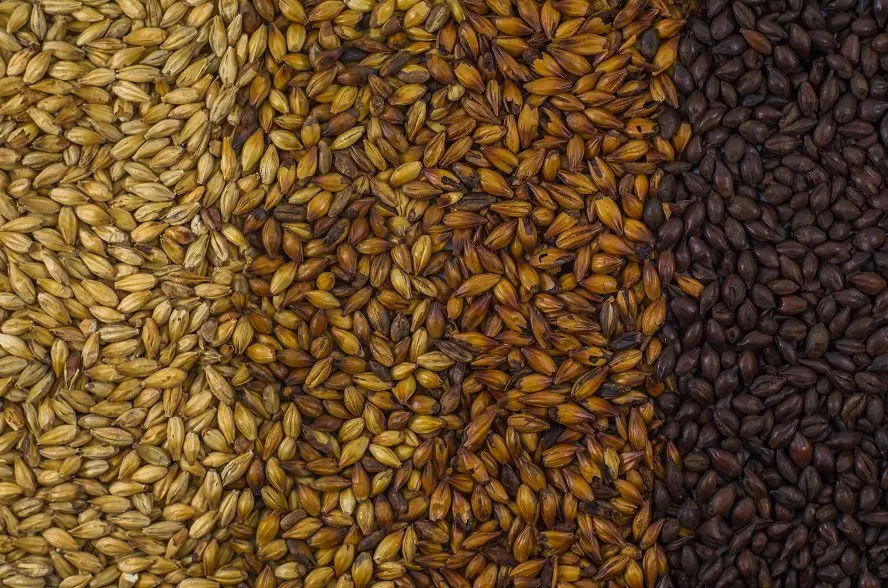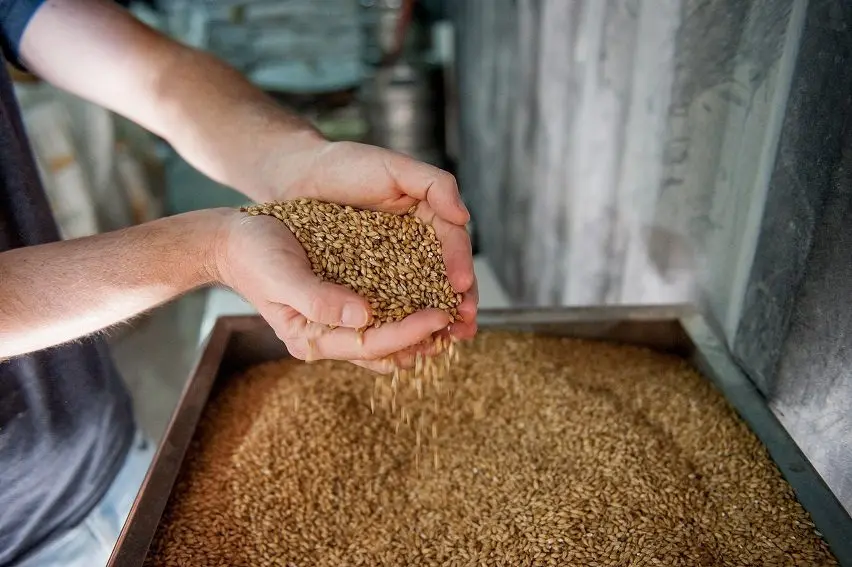Contents
It can be difficult for beginner homebrewers to sort through the assortment of beer malts, since dozens of types and varieties are sold in specialized stores, and the difference between them is not obvious. In this article, we will deal with the basic characteristics that you need to pay attention to when buying, as well as consider the most popular beer malts.
Brief theory
Malt in brewing is a partially germinated and dried grain, in which enzymes are released that are capable of converting starch in grain into sugar at a temperature of 61-72 ° C (saccharification). In turn, the yeast converts sugar into alcohol and carbon dioxide, thus forming the strength of the beer.
However, malt is not only a source of sugars – it is more than other ingredients (hops, yeast and water) that forms the aroma, color and taste of beer. Most brewers use barley malt as their base because its enzymes are the most active (high diastatic power) and the organoleptic properties pair well with hops.
During drying, the malt may be heat-treated to change its flavor and color, and this will eventually be reflected in the beer. However, heat treatment has a negative effect – it reduces the activity of enzymes. Often, the stronger the roast, the lower the diastatic power of the malt.

In order to achieve outstanding organoleptic properties of beer and at the same time process starch into alcohol (to get a fortress), brewers can use several types of malts when brewing one batch, which are usually divided into base and special ones.
A list of all the malts in a beer recipe is called a “pile”. Abroad, the concept of “grain account (malt account)” is used – this is a list of all malts and other additives in the composition, indicating their weight part to the total mass of ingredients. Often, the brewer who developed the recipe keeps the grain count of the beer secret so that it cannot be repeated by competitors.
base malt – has a sufficient amount of enzymes (primarily alpha and beta-amylase) to decompose starch into sugars. The greater its diastatic power, the better. The proportion of base malt in the grist reaches 100%, which means it can be the only malt in the beer. However, this situation is rare due to the “poor” organoleptic properties of the resulting drink. To solve this problem, several types of base malts are combined in recipes.
Special malt – affects the color, aroma, taste, aftertaste, density and other characteristics of beer. Specialty malts contain little or no enzymes and are therefore not suitable for starch digestion and can only be used in beer brewing in combination with base malts.
There are two types of special malt for beer:
- caramel – before heat treatment, partial mashing takes place (decomposition of starch into sugar), as a result, the released sugar turns into caramel;
- burnt – starch is not split before heating, so there are no notes of sweetness in such malt, but high temperature destroys all enzymes and even starch.
The amount of specialty malt in the grist varies from 3-25%. Most beer styles use 1 base and up to 7-8 specialty malts.
Important quality characteristics of malt for beer
Each malt sold must have a quality certificate that lists its characteristics. When buying, the following values uXNUMXbuXNUMXbare first evaluated:
- Diastatic force – shows the activity of amylases and enzymes that break down starch. Relevant only for base malt and should not be lower than 220 Windisch-Kolbach units (WK);
- Extractivity – mass fraction of dry, water-soluble substances in malt. It affects both the strength and organoleptic properties. Minimum malt extract for beer 80%;
- Protein content – an excess of protein substances leads to cloudiness of the beer, and a lack of protein slows down the yeast. In all malts (except wheat), the protein content should be no more than 11,5%;
- The number of Kolbach is the total amount of soluble proteins in the malt. The normal value is 36-42%;
- Color – determines the belonging of malt to a particular variety. Malt color is measured on the SRM scale in the US and on the EBC scale in Europe. Pale malt has a color of 3-4 EBC, medium color – 5-8 EBC, and dark – 8-10 EBC and above;
- Wort color after boiling – allows you to predict the color of the finished beer. For pale malts, this figure is in the range of 5-7 EBC;
- Wort viscosity after boiling – affects the crushing of malt, wort filtration, the duration of saccharification and clarification of the finished beer. For brewing malt, the normal value of this indicator is always greater than 1,55 mPa s;
- Humidity – high-quality malt must be dry, otherwise it does not saccharify starch well and introduces notes of mustiness into the beer. Humidity of malt for beer above 5% is unacceptable.
There are other malt quality parameters: vitreousness, Hartong number, fribialimiter values, nitrogen content, etc., but they are only useful for some recipes and are unlikely to be useful for beginner brewers.

Popular base malts
Pilsner Malt – aka lager molt, is the lightest base malt (2-5 EBC). Used as the base for most lagers, European wheat beers and Belgian ales, but is inherently versatile and suitable for brewing any beer up to an imperial stout. The share in the bill can reach 100%, gives only light grain shades, well reveals the properties of hops.
Ale malt (Pale Ale Malt) – is the basis for most porters, stouts and pale ales, most often used by British brewers. Color – 5-8 EBC. Pale ale malt gives the beer notes of cookies, nuts and a pronounced malt flavor. Share in grist – up to 100%.
Vienna Malt – considered the basis for Vienna lagers, often used by German brewers. It gives the drink a soft malty aroma, toffee and caramel tones on the palate and slightly sour bready tones. Beer turns from light amber to dark orange. The color of the malt itself is 6-10 EBC, the proportion in the grist is 60-100%.
Munich Malt – is considered a conditionally base malt, since its enzymes are able to saccharify only its own starch. Gives the beer a pronounced malty aroma. Suitable for dark and amber lagers, pale ales. Munich malt must always be used in combination with other base malts. Share in grist – up to 60%, color – 12-25 EBC.
Wheat Malt – used as a base for wheat beers and as an addition to light top-fermented varieties (Blond Ale, Kölsch, etc.). Forms a characteristic wheat aroma in the beer, increases the density and stability of the foam, but due to the high protein concentration makes the beer cloudy. Share in grist – up to 80%, color – 3-5 EBC.
Rye Malt Suitable for making German Roggenbier rye beers and some American Pilsners. Recently, rye malt has become more popular as it improves head retention, gives a drier and fuller flavor, and adds rye notes to the aroma and aftertaste. Only non-fermented rye malt can be used as a base, its share in the grist is up to 50%, color is 4-10 EBC.
Popular specialty malts
Biscuit Malt – saturates the beer with the taste of warm bread, the aroma of cookies and the aftertaste of fried toast. Gives the drink a deep amber hue. Share in grist – 3-15%, color – 47-49 EBC.
Victory Malt – almost the same as biscuit, but adds a nutty aftertaste to the beer. Chromaticity – 47-49 EBC, share in grist – 3-15%.
Acid Malt – German malt produced by partial lactic acid fermentation. The main purpose of the application is to increase the acidity of the wort. Acid malt makes pale beers richer. The share in grist is up to 5%.
Melanoidin Malt – similar in properties to Munich malt, but more aromatic and darker. Able to enhance the taste of beer and gives a rich red color. It is an essential ingredient in red ales. Chromaticity – up to 80 EBC, share in grist – up to 20%.
Popular varieties of roasted specialty malts:
- Chocolate Malt – brings a roasted aroma and dark color to the beer. In small quantities, it gives a ruby color and light nutty notes of taste, with a large concentration in beer, the taste of roasted coffee and cocoa aroma appear. An important ingredient in porters, stouts and other dark varieties. Share in grist – 3-15%, color – 800 EBC;
- Carafa and Black Malt (Carafa and Black Malt) – varieties of malt with sharp coffee and chocolate tones in taste. Usually used in small amounts for a rich black color and complex flavor, sometimes used as a substitute for chocolate malt in stouts. Share in grist – 1-10%, color – up to 1800 EBC.
Caramel Malts (Caramel or Crystal Malts) – a large group that is used in all types of beer with a high wort gravity. Such malt is transparent, light and dark. It complements the drink with caramel shades in the aroma and aftertaste, and also increases the intensity of the taste. Chromaticity – 5-236 EBC, share in grist – 5-25%.
In addition to those listed, other, rarer types of special malt are also used: amber, honey, peat, etc. A separate place in the grist is occupied by unmalted raw materials (unmalted) – cereals that have not been germinated, therefore they are not malt. Nezhenka is added both fried and simply in the form of cereals.

It is worth remembering that a large number of malts in one grist usually does not make a tasty beer, since different types and types of malts begin to interrupt each other’s organoleptic properties. There are many successful recipes that use only 2-3 different malts.
Famous brands of beer malt
World-renowned manufacturers are Castle Malting (Belgium) and Weyermann (Germany). Castle Malting has been in business since 1878 and offers over 70 types of base and specialty beer malts. Weiermann supplies the market with no less quality products and is considered a leader in Europe, but their malt is an order of magnitude more expensive than Castle Malting. The BestMalz brand is considered to be the optimal ratio between price and quality of German malt for beer.
Among Russian malt producers, Kursk Solod and Rostock enterprises stand out, their products are 2-3 times cheaper than imported analogues, but the assortment is poorer. Disadvantages of all Russian malt producers: lower extract and diastatic strength, higher protein content, and sometimes poor cleaning of debris. Experienced brewers who want to save money use Russian base malts and foreign specialty malts.









